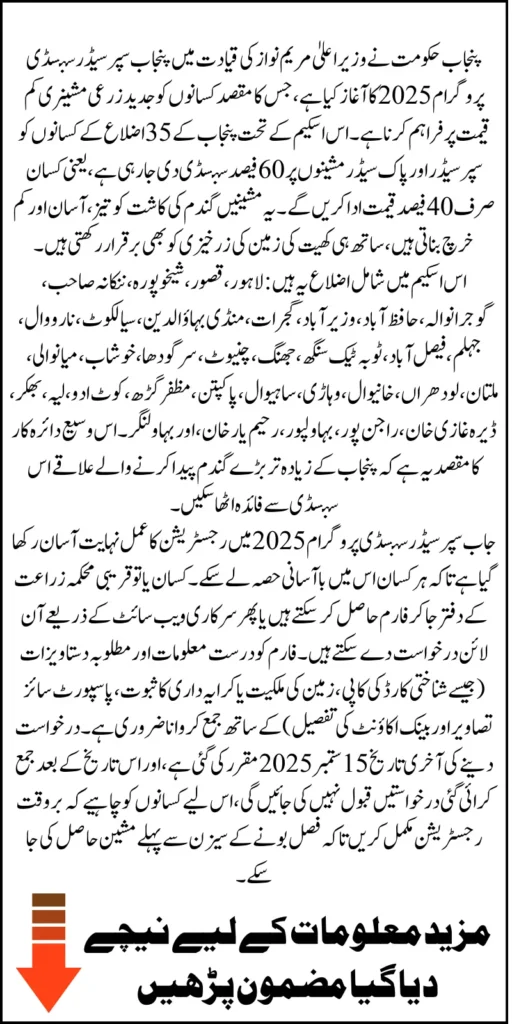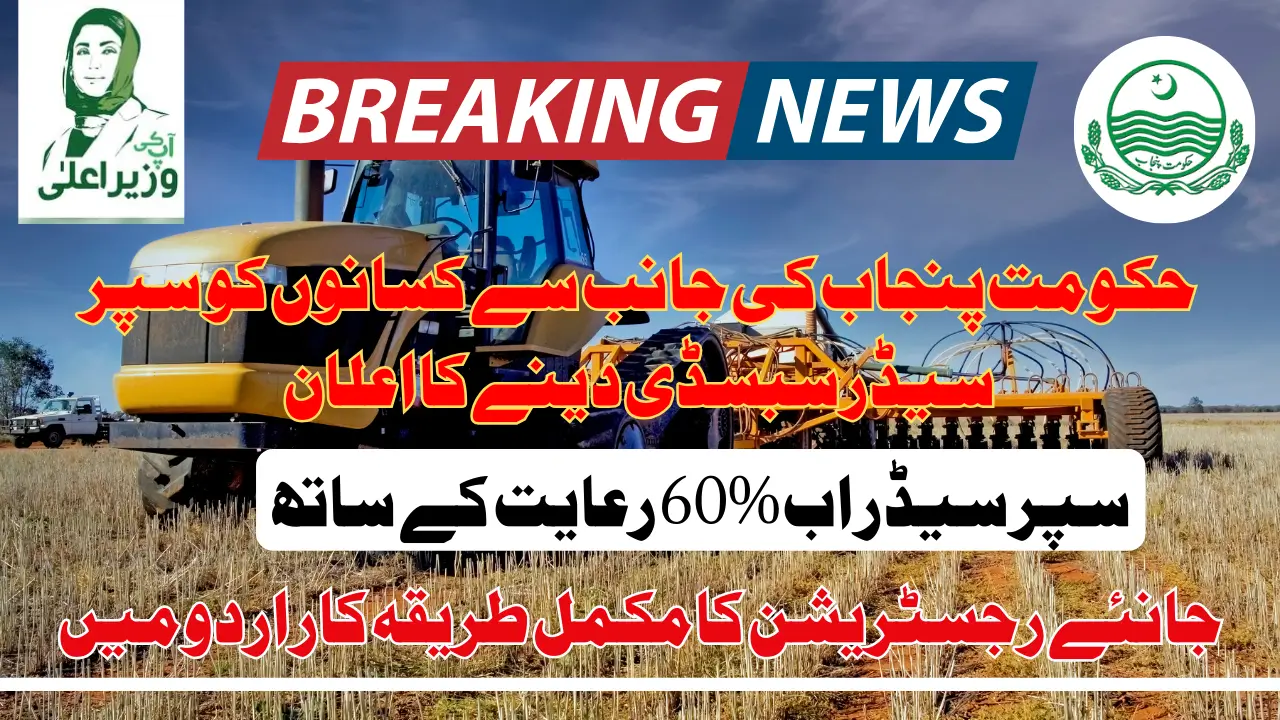Punjab Super Seeder 60% Subsidy Program 2025
Punjab Super Seeder 60% Subsidy Program 2025: Under the leadership of Chief Minister Maryam Nawaz, the provincial government has rolled out the Punjab Super Seeder Subsidy Program 2025. The aim is to make modern farming tools affordable for local farmers so they can save time, reduce costs, and grow more wheat.

The scheme covers 35 districts and offers a massive 60% subsidy on two important pieces of farming equipment: the super seeder and the Pak seeder. This means farmers will pay only 40% of the total cost. By introducing this scheme, the government hopes to modernize farming methods and improve wheat yields while protecting the soil and environment.
You Can Also Read: CM Punjab T Cash Card 2025 Offering Free Travelling With Cash Withdrawal At Shopping Malls And ATM Know
Why This Program Was Introduced
In recent years, wheat production in Punjab has faced several challenges. Farmers have been relying on outdated methods, which require more labor, more fuel, and more time. This slows down the sowing process and limits crop yields.
Another major problem is stubble burning, the practice of setting leftover crop residue on fire after harvest. While this clears the field quickly, it causes serious air pollution and reduces soil fertility. The new machines provided under this scheme allow farmers to plant seeds directly without burning residue, making farming cleaner and more sustainable.
Areas Covered by the Scheme
The government has included 35 districts in this program to make sure farmers from all major wheat-producing regions benefit from the subsidy. The coverage is wide enough to include both central and southern Punjab.
| District | District | District |
|---|---|---|
| Lahore | Faisalabad | Pakpattan |
| Kasur | Toba Tek Singh | Muzaffargarh |
| Sheikhupura | Jhang | Kot Addu |
| Nankana Sahib | Chiniot | Layyah |
| Gujranwala | Sargodha | Bhakkar |
| Hafizabad | Khushab | D.G. Khan |
| Wazirabad | Mianwali | Rajanpur |
| Gujrat | Multan | Bahawalpur |
| Mandi Bahauddin | Lodhran | Rahim Yar Khan |
| Sialkot | Khanewal | Bahawalnagar |
| Narowal | Vehari | |
| Jhelum | Sahiwal |
By focusing on these districts, the program ensures that a large portion of Punjab’s wheat farmers will have access to affordable modern farming equipment.
You Can Also Read: Punjab Honhaar Scholarship Phase 2 2025 Is Now Open Via Online Know Which Colleges And Universities
Goals of the Subsidy Program
The government designed this program with clear targets in mind to help farmers, the economy, and the environment.
Main goals include:
- Increase wheat production across the province.
- Reduce farming time and operational costs.
- Introduce efficient and modern agricultural technology.
- Eliminate stubble burning after harvest.
- Reduce air pollution linked to residue burning.
- Keep the soil healthy and fertile.
- Promote farming methods that are eco-friendly and sustainable.
By following these goals, the program will help farmers earn more, keep their land in good condition, and supply better-quality crops to the market.
Who Is Eligible to Apply
Not every farmer can apply, there are rules to make sure the subsidy reaches genuine cultivators.
The eligibility conditions are:
- Applicant must be 65 years old or younger.
- Must own or legally rent (tenancy) agricultural land.
- Must be a permanent resident of Punjab.
- Must have no unpaid loans or bank blacklist record.
- Must have at least 10 acres of land under wheat cultivation.
- Must agree to use the machine only for their own farming needs.
- All submitted details must be correct and verifiable.
Meeting these conditions is essential for receiving the subsidy.
You Can Also Read: Punjab Green Tractor Scheme Phase 2 2025 Announced To Collect New Applications In August Know Full Guide
Documents Required for Application
Farmers need to prepare some documents before applying so that the process is smooth and there are no delays.
Required documents:
- CNIC copy.
- Proof of land ownership or tenancy agreement.
- Recent passport-size photographs.
- Bank account details.
- Any other documents requested by the Agriculture Department.
Having all of these ready will make the application process quick and trouble-free.
How to Apply for the Program
The application process is simple and accessible for all farmers. You can apply either online or at your nearest Agriculture Department office.
Steps to apply:
- Visit the Agriculture Department office or official program website.
- Collect the application form and fill it with correct details.
- Attach all the required documents.
- Keep a copy of your form and submission receipt.
Applying early is better because it ensures faster processing and a higher chance of getting the machine before sowing season.
You Can Also Read: Punjab Honhar Scholarship 2025 Reopened Through Online Portal For 30000 Students Know Registration
How Applications Are Checked
Once the form is submitted, it goes through a verification process to ensure eligibility. The Agriculture Department will:
- Check land ownership or tenancy documents.
- Verify bank records to confirm no loan defaults.
- Confirm wheat cultivation on at least 10 acres.
- Match CNIC details with official records.
- Validate all submitted documents.
- Inspect the farm if needed.
If everything is correct, the farmer will receive a call or message with approval details and collection instructions for the machine.
Application Deadline
The last date to apply for the subsidy is 15 September 2025. Applications submitted after this date will not be considered in the current phase, and farmers will have to wait for the next phase, which could delay their plans for months. The Agriculture Department has made it clear that late submissions will not be entertained under any circumstances.
Applying early not only secures your place in the program but also ensures you receive your machine well before the wheat sowing season begins. This gives farmers enough time for setup, training on how to operate the equipment, and planning for the upcoming crop cycle. Early planning reduces last-minute stress and helps achieve better results in the field.
You Can Also Read: Punjab Ration Card Program 2025 Registration Process Via Online And Office For 3000 Monthly Payment Know
Help and Support for Farmers
The government has set up a helpline for guidance: 0800-17000, available from 8:00 am to 8:00 pm. Farmers can use this to get help with eligibility questions, document requirements, and the application process.
QR codes are also available for quick access to the official website and Facebook page for program updates.
Final Words
The Punjab Super Seeder Subsidy Program 2025 is a big step towards modernizing farming in Punjab. With a 60% subsidy on advanced machines, the government is helping farmers save time, reduce costs, and increase wheat yields. Covering 35 districts, this initiative directly addresses major issues like stubble burning, soil damage, and outdated farming practices.
By applying before the 15 September 2025 deadline, eligible farmers can secure their machines in time for the wheat season. This program not only benefits individual farmers but also supports Punjab’s agricultural growth, improves environmental health, and strengthens food security for the province.
You Can Also Read: PM Laptop Loan Scheme 2025 For Youth to Start Online Earning On Easy Monthly Installments Know Details
FAQs
Who can apply for this scheme?
Farmers under 65 years old, with at least 10 acres of wheat cultivation, who meet the eligibility criteria.
How much subsidy will the government provide?
The government will cover 60% of the machine’s cost, and the farmer will pay only 40%.
What is the last date to apply?
The deadline to submit applications is 15 September 2025.
What machines are included in the scheme?
The scheme covers the super seeder and Pak seeder, both designed for direct wheat sowing.
Why is this scheme important?
It helps increase wheat production, saves resources, and prevents environmental damage from stubble burning.
